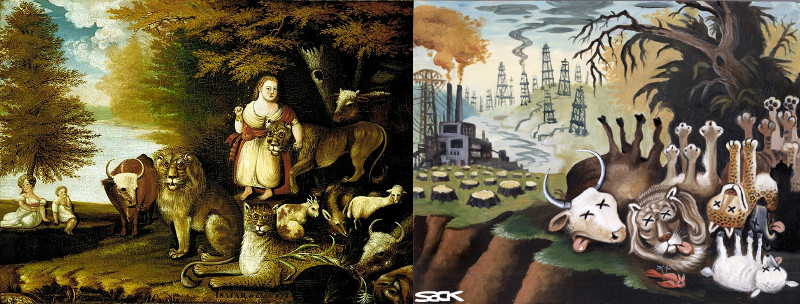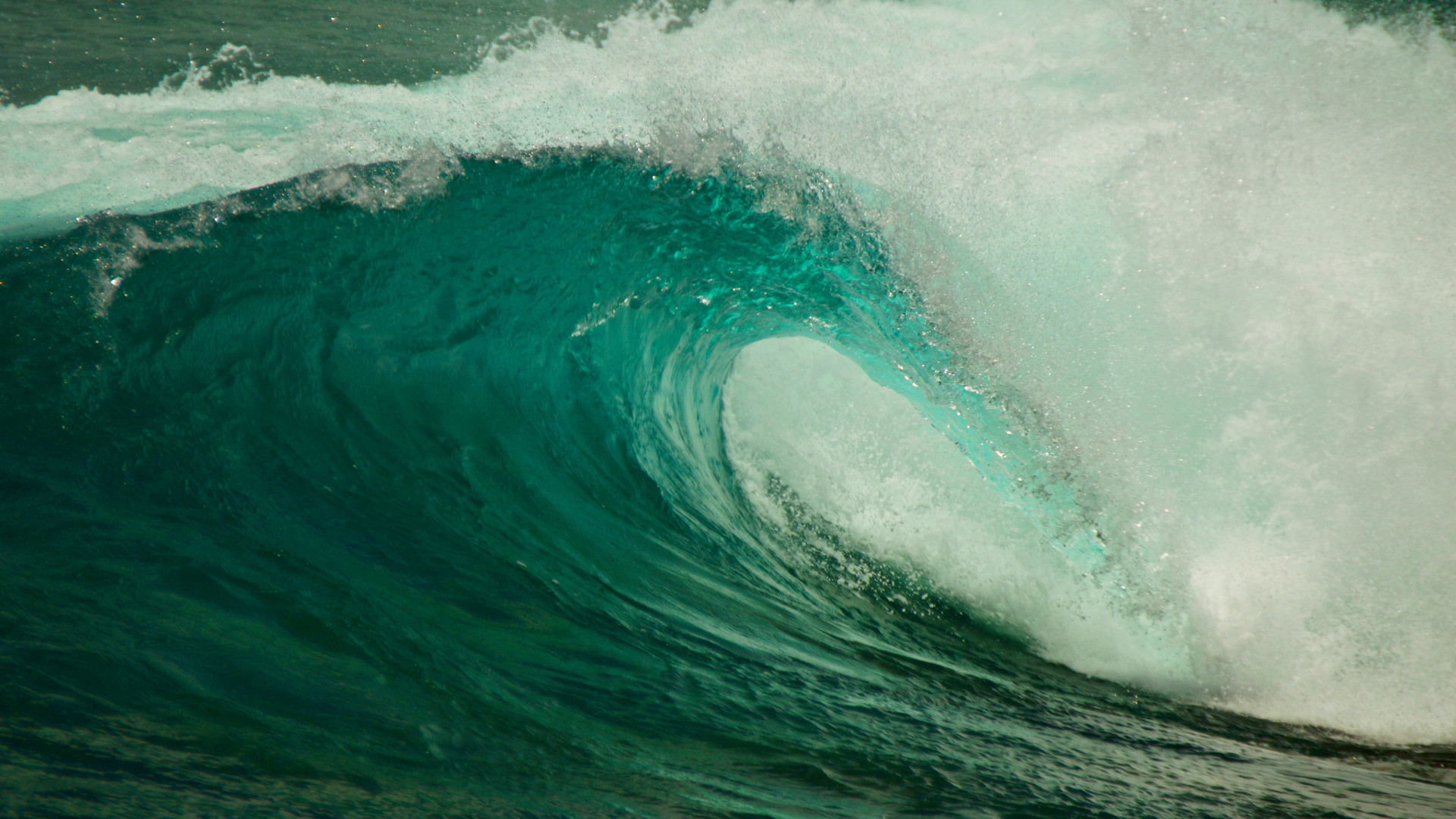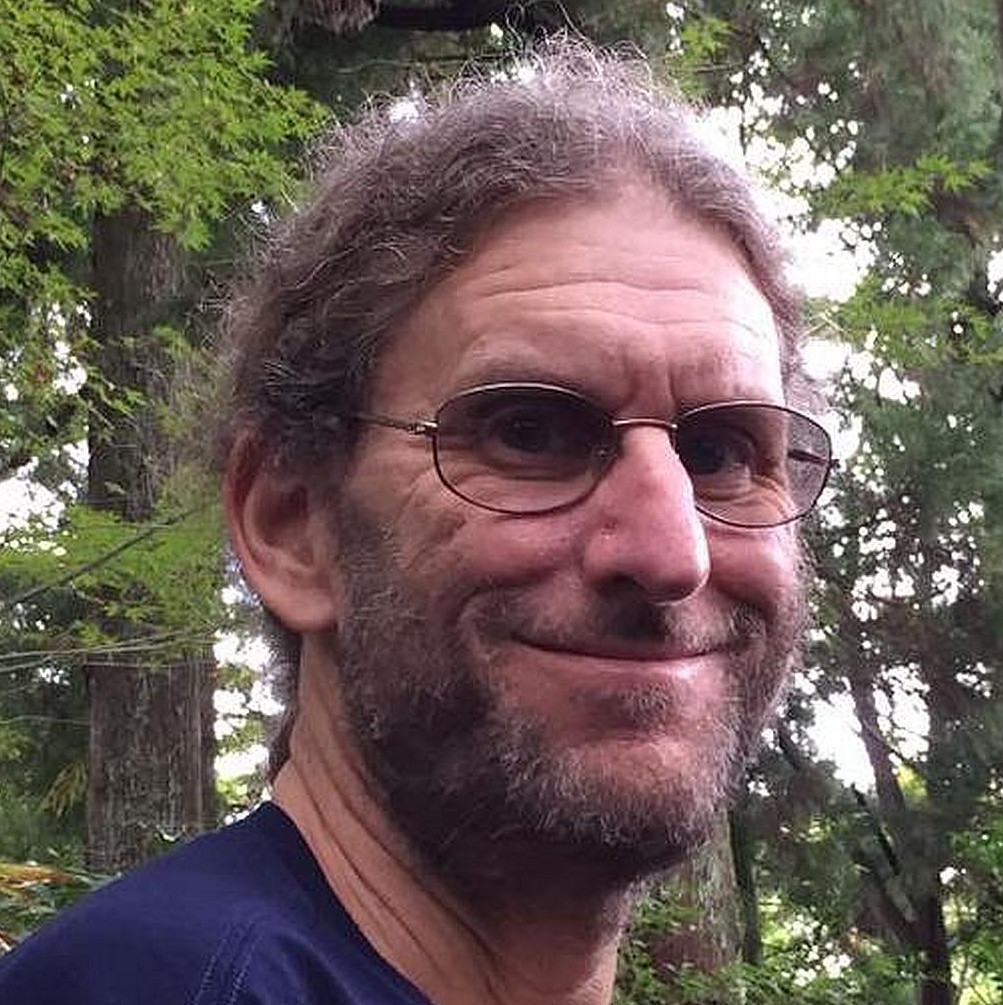There’s really no serious scientific debate about humanity’s contributions to changes in the global climate caused by increasing use of fossil fuels coupled with the deforestation and land conversion eating away at the planet’s lungs. Nor is there any immediate prospect of reining in the four accompanying horsemen of the ecological apocalypse: wholesale loss of biological diversity; transformation and loss of a diversity of ecosystems and the services they provide; environmental pollution; and human population growth and patterns of consumption.
At the same time, the weaving together of metaphors for our time — tipping points, regime shifts and the balance of nature — into a consistent narrative of environmental disaster that McKibben refers to in his book Eaarth (2000) as “collapse porn,” and which “[gives] us the slightly scary shiver of imagining our lives tumbling over a cliff” echoes the depiction of the sublime in late 19th and early 20th century landscape paintings. (For additional discussion of ecology, the sublime, and landscape art, see my 2013 paper “The suffocating embrace of landscape and the picturesque conditioning of ecology.”)
This new, contemporary sublime not only engenders feelings of awe in the face of forces larger than ourselves, it also threatens to lead us into a sense of powerlessness and paralysis when it comes to ameliorating or acclimating to these large changes. We need new metaphors — metaphors that embrace the chaotic dynamics of constant change, unsteadiness, and evolution — if we are to live on a planet that despite our wishful thinking about balance of nature to the contrary, has always been capricious, unpredictable and fundamentally uncaring. As Ralph Waldo Emerson wrote in his 1836 essay “Nature,” “[T]here is throughout nature something mocking, something that leads us on and on, but arrives nowhere, keeps no faith with us.”
In short, we may be on a new world, but this new world — McKibben’s Planet Eaarth — is still Hobbes’ nasty and brutish Planet Earth.
Tipping points are precarious and threaten our sense of balance. But what about the new regimes we enter after we pass tipping points? In the postcolonial world of the 1950s and 1960s, regime changes — after which newly emerging nations shifted their foreign alignments towards, for example, the Soviet Union or the nonaligned states — were cast in a negative light because they were antithetical to U.S. or NATO ambitions. The superpowers of the day did everything they could to prop up friendly regimes and maintain the stability of the status quo. In contrast, in our post-9/11 world, regime change has become desirable, especially when rogue states cross “red lines.”
But after what I recently dubbed “5/9” — that day in 2013 when we passed an atmospheric tipping point — regime change once again seem to be a bad idea. Although academics tend to use the more neutral term “regime shift” in an attempt to remove the value judgment inherent in “regime change,” regime shifts, such as the shift in global climate that we are undergoing now, are nonetheless generally seen as undesirable. Consequently, a large amount of effort, at least as measured by allocation of research dollars in the United States and European Union, continues to be focused on identifying early-warning indicators of impending regime shifts and developing strategies to avert them. (In the spirit of full disclosure, my own research on tipping points, thresholds, indicators of regime shifts and alternative states in aquatic ecosystems has been generously supported by the National Science Foundation.)
Where geopolitical actors look to regime change to re-stabilize a destabilized situation, ecologists and environmental scientists look for ways to maintain existing stability and avoid regime shifts. Common to both is an interest in stability — its continued persistence or its immediate return. When we think of stability, we think of equilibrium: a steady state in which interacting agents or forces balance each other, like equal weights on the scales of justice. For ecologists and environmentalists like Bill McKibben, a regime shift is undesirable because it threatens the “Balance of Nature,” the state in an ecosystem when the interrelationships of organisms are harmoniously integrated to a considerable degree.
The idea that nature is in balance has deep, rarely explored roots. In fact, the Balance of Nature is so deeply embedded in our discussion of these ideas that even in detailed analyses of environmental metaphors, the metaphor of a balance of nature itself is not even considered metaphoric. Rather, the focus is on if, and how quickly, social and ecological systems can return to a sustainable, equilibrium condition, albeit a new one, following some sort of “disturbance.” Equally penetrating is the idea — illustrated succinctly by the contrast between Edward Hicks’ 1830s painting The Peaceable Kingdom and Steve Sack’s 2004 updated version [both below] — that there is a prelapsarian, perfectly balanced nature out there, apart from people, and that human beings have destroyed this balance through science, technology, or, in fact, any activity beyond simple hunting and gathering.

The Balance of Nature metaphor is completely at odds with the by now well-established facts of evolution: all life (on both Earth and McKibben’s “Eaarth”) is derived from a single common ancestor, and humans are as much a part of this continuously unfolding process as are all the other plants, animals, bacteria, fungi and viruses with which we share the planet. Evolution is a constant struggle for existence: More than 99 percent of all species that have evolved on Earth in the past 4 billion years or so have gone extinct, and there is no reason to presume that humans will, in the long run, fare any differently. Yet we persist in in removing humans from the natural world, which the Dictionary of Ecology defines as:
[a] term that is applied to a community of native plants and animals. ‘Future-natural’ describes the community that would develop were human influences to be removed completely and permanently, but allows for possible changes in climate or site. ‘Original-natural’ describes a community as it existed in the past, with no modification by humans. ‘Past-natural’ describes the condition in which the present features are derived directly from those existing originally, with relatively little modification by humans. ‘Potential-natural’ describes the community that would develop were human influence removed, but the consequent succession completed instantly (future changes in climate or site are not taken into account). ‘Present-natural’ describes the community that would exist now had there been no human modification. Because of the dynamic nature of any ecosystem, this condition may not be identical to the last original-natural state before human intervention began.
Climatologists, oceanographers, ecologists, evolutionary biologists and many others have repeatedly documented that nature is an ever-changing and at best ephemerally stable — on virtually any time scale — dynamical system, the state of which still can be reliably forecast only weeks in advance. In fact, as President Obama noted in his Georgetown speech, the most extreme scenario of climate change forecast by the Intergovernmental Panel on Climate Change significantly underestimates the dynamics and magnitude of climate changes we are currently experiencing. Our inability to forecast and manage regime shifts of the global climate system or to predict and direct regime changes using diplomacy or warfare spring from the same source: reliance on metaphors and derived models based on a Balance of Nature (or a Balance of Power).
So if the Balance of Nature is, and always has been, a will-o’-the-wisp, what do we do and how do we live? Many on both the extreme right and the extreme left would argue that the best path is laissez faire individualism, in which each of us builds the best fortress we can afford, complete with levees, storm shelters and well-stocked gun racks, and damn the consequences if the levees divert the floodwaters to our neighbors downstream, the storm shelters can only hold us and our close kin, and the guns keep spawning unforeseen chaotic events. A casual perusal of any daily newspaper, blog or Twitter feed suggests that this approach clearly has broad appeal. But after 5/9, McKibben’s prescription for living durably, sturdily, stably, hardily and robustly in small redoubts seems unlikely to work — and it didn’t work well in the past, either. Our best efforts to identify and forecast planetary tipping points in a world that isn’t now, and has never been, in a state of balance, can only fail while simultaneously raising unfounded hopes.
Rather, we must re-envision the sublime and re-embrace the unpredictability unfolding daily around us. The real world, in which humans are just another organism, is a messy place, but messiness does not have to be bad, and we should celebrate its ever-changing tapestry. In The Origin of Species, Charles Darwin described a struggle for existence between organisms and the world around them, a struggle that included not only the elements but other organisms. He concluded The Origin (6th edition) by writing:
It is interesting to contemplate a tangled bank, clothed with many plants of many kinds, with birds singing on the bushes, with various insects flitting about, and with worms crawling through the damp earth, and to reflect that these elaborately constructed forms, so different from each other, and dependent upon each other in so complex a manner, have all been produced by laws acting around us. These laws, taken in the largest sense, being Growth with reproduction; Inheritance which is almost implied by reproduction; Variability from the indirect and direct action of the conditions of life, and from use and disuse; a Ratio of Increase so high as to lead to a Struggle for Life, and as a consequence to Natural Selection, entailing Divergence of Character and the Extinction of less improved forms. Thus, from the war of nature, from famine and death, the most exalted object which we are capable of conceiving, namely, the production of the higher animals, directly follows. There is grandeur in this view of life, with its several powers, having been originally breathed by the Creator into a few forms or into one; and that, whilst this planet has gone circling on according to the fixed law of gravity, from so simple a beginning endless forms most beautiful and most wonderful have been, and are being evolved.
As Darwin knew, and as ecologists and evolutionary biologists have demonstrated time and again, although virtually all of the organisms that have evolved and lived on Earth have already gone extinct, evolution continues nonetheless. There are deterministic laws to evolution, but their actual operation leads to chaotic outcomes. But “chaotic” is neither chaotic nor unpredictable. Rather, in a chaotic system, fixed (deterministic) rules give rise to completely different, yet entirely predictable, outcomes depending solely on the initial state of the system. The real challenge is not in learning the rules, but in learning to ride the chaotic wave.
Perhaps we should stop pretending that we live in Dr. Pangloss’s best of all possible worlds and instead cultivate Candide’s garden. When we look around us, we will daily witness the ceaseless changes to our world where all the plants and animals, including us, are on chaotic stages — out-of-balance and just trying to survive. This dynamic, unpredictable and yes, unstable, ecological theater in which most organisms simply and indifferently eat other ones and push one another out of the way, is the decisive expression of the sublime — the terrible uncertainty and ultimate incomprehensibility of the world around us that includes us.
We can keep on trying to balance our unbalanced planet; tweaking, geo-engineering and ultimately destroying what our metaphors do not allow us to understand, or we can construct new metaphors so that we can more quietly observe the world around us and more gently live in it, on it and with it.


